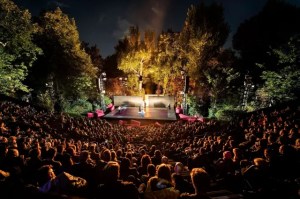Plans for West End’s Saville Theatre criticised in new Theatres Trust statement
Planning discussions are in progress to transform the Saville Theatre into a performance venue and hotel – but a new objection has been raised by the Theatres Trust this week

The Theatres Trust has issued a public statement expressing “concerns” over proposed plans for the empty Saville Theatre on Shaftesbury Avenue.
The Saville Theatre, currently an Odeon cinema, has hosted numerous iconic performances and artists since its construction in the 1930s, including the Rolling Stones, Chuck Berry, The Who, and Jimi Hendrix.
Yoo Capital acquired the site in 2021, and the real estate investment firm subsequently revealed to much excitement and fanfare that Cirque du Soleil Entertainment Group, who regularly present huge circus shows in London, plans to make the venue its first permanent home in the UK.
Original plans for the venue were revealed in March 2024 – and included proposals to “re-introduce a live performance venue (theatre) to this site and introduce a new hotel use on upper floors. The proposed development includes a six-storey extension, plus plant, on top of the existing building.”
There would be a “part-demolition, part-retention and stabilisation and refurbishment of the existing Grade-II listed building. New basement levels will be excavated to accommodate the theatre, with the introduction of ancillary retail and theatre lobby, box office and front of house facilities at ground floor level.”
A fresh planning statement, reportedly created while working “closely with LBC, GLA, Historic England and Theatres Trust to respond to consultation feedback” was released last month, updated existing proposals. The new plans included a 35 per cent reduction in the upper level addition to the top of the venue, reducing the overall venue height by 8.36m.
The performance space would still be located underground, with the “boutique hotel” on the upper floors.

The February 2025 update drew a range of responses from Historic England and the Theatres Trust.
A letter from Historic England on 11 March doubled down on previous criticisms, saying: “We consider the changes made have not markedly reduced the harm the scheme would cause to the listed building by comparison to that first submission. We maintain our objection to the application, which would cause a high level of harm to the listed building.”
The organisation noted that the theatre auditorium has now been sunk deeper underground, with the basement depth increasing from 17.4m to 21.8m (compared to existing 7.8m). This would essentially mean, in their eyes, that the auditorium would sit below the Saville Theatre building, rather than inside it.
In their words: “We consider that the potential heritage benefit of returning theatre use to the building would be limited in this scheme. The scheme would vastly increase the depth of the basement, and the theatre auditorium would be contained entirely below ground rather than in even an approximation of its original position in the building.
“The revised designs place it even deeper underground than in the original submission, with only very minimal spatial crossover between the historic and proposed auditoria.”
The organisation also emphasised a greater need for further investigative works to confirm Regent’s Street Disease in the building.
The Theatres Trust CEO Joshua McTaggart was equally critical in his comments, saying: “The plans, if permitted, would see the theatre space reduced and relocated to subterranean levels with the majority of the Grade-II listed building converted to hotel use.
“The Theatres Trust has objected to similar schemes for this site in the past and despite engaging proactively with the applicant, the current plans do not sufficiently overcome our concerns nor provide the best use of the building.”
McTaggart continued: “We firmly believe that a dedicated theatre scheme with larger-scale offer is clearly the optimal use for the Saville, and crucially would be a better long-term opportunity for cultural and economic growth in the West End. It would be a welcome addition to both the local area and the UK’s theatre eco-system.
“We are confident that there are established theatre operators and producers who would be keen to take on an 800-1,000 seat venue and that this could be created without the additional non-cultural development and harm to the historic building required to create the proposed scheme.”
Further clarifications and updates are expected in the near future. McTaggart concluded his remarks by stating: “If the scheme goes ahead in its current form, it is a missed opportunity to revitalise an important theatre with tangible economic and cultural placemaking benefits.”














